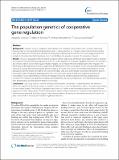Files in this item
The population genetics of cooperative gene regulation
Item metadata
| dc.contributor.author | Stewart, Alexander J | |
| dc.contributor.author | Seymour, Robert M | |
| dc.contributor.author | Pomiankowski, Andrew | |
| dc.contributor.author | Plotkin, Joshua B | |
| dc.date.accessioned | 2021-03-03T13:30:05Z | |
| dc.date.available | 2021-03-03T13:30:05Z | |
| dc.date.issued | 2012-09-06 | |
| dc.identifier | 272143897 | |
| dc.identifier | 21bbe51d-3c27-4df8-aaae-929f3c4d437c | |
| dc.identifier | 22954408 | |
| dc.identifier | 84865715647 | |
| dc.identifier.citation | Stewart , A J , Seymour , R M , Pomiankowski , A & Plotkin , J B 2012 , ' The population genetics of cooperative gene regulation ' , BMC Evolutionary Biology , vol. 12 , 173 . https://doi.org/10.1186/1471-2148-12-173 | en |
| dc.identifier.issn | 1471-2148 | |
| dc.identifier.other | PubMedCentral: PMC3537746 | |
| dc.identifier.other | ORCID: /0000-0001-5234-3871/work/86538494 | |
| dc.identifier.uri | https://hdl.handle.net/10023/21546 | |
| dc.description | JBP and AJS acknowledge funding from the Burroughs Wellcome Fund, the David and Lucile Packard Foundation, the James S. McDonnell Foundation, the Alfred P. Sloan Foundation, grant #D12AP00025 from the U.S. Department of the Interior and Defense Advanced Research Projects Agency, and grant RFP-12-16 from the Foundational Questions in Evolutionary Biology Fund. AP acknowledges grants from the Natural Environment Research Council (NE/G00563X/1) and the Engineering and Physical Sciences Research Council (EP/F500351/1, EP/I017909/1). AJS also acknowledges an EPSRC PhD Plus fellowship. | en |
| dc.description.abstract | Background: Changes in gene regulatory networks drive the evolution of phenotypic diversity both within and between species. Rewiring of transcriptional networks is achieved either by changes to transcription factor binding sites or by changes to the physical interactions among transcription factor proteins. It has been suggested that the evolution of cooperative binding among factors can facilitate the adaptive rewiring of a regulatory network. Results: We use a population-genetic model to explore when cooperative binding of transcription factors is favored by evolution, and what effects cooperativity then has on the adaptive re-writing of regulatory networks. We consider a pair of transcription factors that regulate multiple targets and overlap in the sets of target genes they regulate. We show that, under stabilising selection, cooperative binding between the transcription factors is favoured provided the amount of overlap between their target genes exceeds a threshold. The value of this threshold depends on several population-genetic factors: strength of selection on binding sites, cost of pleiotropy associated with protein-protein interactions, rates of mutation and population size. Once it is established, we find that cooperative binding of transcription factors significantly accelerates the adaptive rewiring of transcriptional networks under positive selection. We compare our qualitative predictions to systematic data on Saccharomyces cerevisiae transcription factors, their binding sites, and their protein-protein interactions. Conclusions: Our study reveals a rich set of evolutionary dynamics driven by a tradeoff between the beneficial effects of cooperative binding at targets shared by a pair of factors, and the detrimental effects of cooperative binding for non-shared targets. We find that cooperative regulation will evolve when transcription factors share a sufficient proportion of their target genes. These findings help to explain empirical pattens in datasets of transcription factors in Saccharomyces cerevisiae and, they suggest that changes to physical interactions between transcription factors can play a critical role in the evolution of gene regulatory networks. | |
| dc.format.extent | 10 | |
| dc.format.extent | 560281 | |
| dc.language.iso | eng | |
| dc.relation.ispartof | BMC Evolutionary Biology | en |
| dc.subject | Algorithms | en |
| dc.subject | Binding sites/genetics | en |
| dc.subject | Evolution, molecular | en |
| dc.subject | Gene expression regulation | en |
| dc.subject | Gene regulatory networks | en |
| dc.subject | Genetics, population/methods | en |
| dc.subject | Models, genetic | en |
| dc.subject | Mutation rate | en |
| dc.subject | Protein binding | en |
| dc.subject | Selection, genetic | en |
| dc.subject | Transcription factors/metabolism | en |
| dc.subject | QH301 Biology | en |
| dc.subject | QH426 Genetics | en |
| dc.subject.lcc | QH301 | en |
| dc.subject.lcc | QH426 | en |
| dc.title | The population genetics of cooperative gene regulation | en |
| dc.type | Journal article | en |
| dc.contributor.institution | University of St Andrews. Applied Mathematics | en |
| dc.identifier.doi | 10.1186/1471-2148-12-173 | |
| dc.description.status | Peer reviewed | en |
This item appears in the following Collection(s)
Items in the St Andrews Research Repository are protected by copyright, with all rights reserved, unless otherwise indicated.

